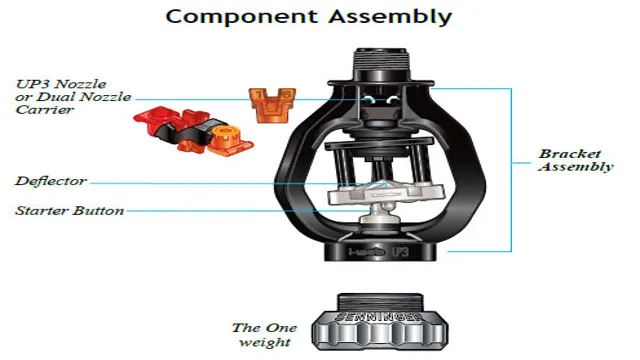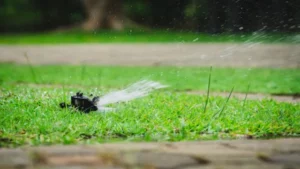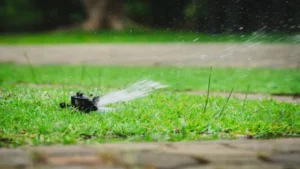Have you ever wondered how sprinkler systems work? They may seem like a simple network of pipes and sprinkler heads, but there are many different parts that make up a functioning system. From the water supply to the controller, each component plays a vital role in ensuring that the system operates efficiently and effectively. At its core, a sprinkler system works by distributing water evenly across an area in order to irrigate crops or maintain a lush green lawn.
However, the system is much more complex than that. There are valves that open and close to determine when and where water is distributed, pipes that transport the water throughout the system, and sensor devices that detect changes in weather or soil moisture levels. Understanding the different parts of a sprinkler system can help you troubleshoot any problems that may arise and keep your system running smoothly.
Whether you’re a homeowner or a farmer, it’s crucial to understand the inner workings of these systems so that you can get the most out of them. So, let’s dive in and explore the different parts of a sprinkler system in more detail. From the basic components like sprinkler heads and pipes to the more complex elements like pressure regulators and backflow preventers, we’ll cover everything you need to know to become a sprinkler system expert.
Sprinkler Heads
If you’re wondering about the different parts of a sprinkler system, one of the key components to think about is the sprinkler head. This is the part of the system that releases water whenever a fire is detected. There are several types of sprinkler head designs available, each with their own unique features and benefits.
For example, some sprinkler heads are spray-type heads that are designed to release water in a fine mist, while others are deluge-type heads that release a large amount of water all at once. Additionally, some sprinkler heads may be designed to work with only certain types of sprinkler system piping, so it’s important to choose the right type of head for your specific needs. With the right combination of sprinkler heads and other system components, you can help protect your property from the dangers of fire.
Rotors vs. Spray Heads
If you’re looking to improve your lawn’s irrigation system, choosing between rotors and spray heads can be a difficult decision. Both types of sprinkler heads have their advantages and disadvantages, so it’s important to understand the differences between them. Spray heads are perfect for watering small areas or specific spots within a larger area such as flowers, bushes, and small patches of grass.
They shoot out water in a fan-like pattern, providing even coverage that’s gentle on delicate plants. They’re also great for customizing the application rate since you can adjust the nozzle to control both the flow rate and the distance the water travels. On the other hand, rotors are better suited for larger areas.
They shoot out a stream of water in a rotating pattern, covering a larger area with each pass. Unlike spray heads that work better at low water pressure, rotors need higher water pressure to work effectively. But, they offer better water efficiency since they provide deeper watering that penetrates deeply into the soil, encouraging deeper root growth.
A good tip is to combine both types of sprinkler heads in your irrigation system. Rotors can take care of larger areas, while spray heads can provide targeted watering for plants that need a little extra attention. By using them together, you can provide proper coverage to all aspects of your lawn or garden and ensure your plants get the right amount of water they need to thrive.
Types of Nozzles
When it comes to watering your lawn or garden, sprinkler heads can be a great option. These types of nozzles are designed to distribute water evenly across a wide area. There are several different types of sprinkler heads available, including impact, rotary, and fixed spray.
Impact sprinklers are typically used for large lawns or gardens and work by rotating in a circle while shooting water in all directions. Rotary sprinklers also rotate, but they tend to cover a smaller area and are better suited for smaller spaces. Fixed spray nozzles are the least expensive option and are ideal for targeted watering of specific plants or areas.
With so many options available, it’s important to choose the right type of sprinkler head based on the size of your lawn or garden and your specific watering needs. By selecting the right type of nozzle, you can ensure that your lawn or garden stays healthy and hydrated throughout the season.
Valves
When it comes to the parts of a sprinkler system, valves play a crucial role. Valves are the control center for the system, regulating the flow of water to different areas of the lawn or garden. There are several types of valves found in a sprinkler system, such as the zone valve, backflow preventer, and pressure regulator.
The zone valve is responsible for opening and closing the water supply to individual sprinkler zones, while the backflow preventer ensures that dirty water doesn’t contaminate the main water supply. Pressure regulators help to maintain a consistent water pressure throughout the system, preventing damaged pipes and wasted water. When these valves are properly maintained and functioning well, they can help ensure the efficient and effective operation of a sprinkler system.
So, always make sure to pay attention to the valves in your sprinkler system and get them checked regularly for any potential issues.
Main Water Line Valve
If you are a homeowner, it is essential to know where your main water valve is located. This valve controls the flow of water into your home, and if you ever need to shut off the water supply, you’ll need to know where it is. The main water valve is usually located near the water meter or where the water enters your home.
It can be a knob or lever that you can turn to shut off the water. It’s important to label the valve so that everyone in your household knows where it is and how to turn it off in case of an emergency. A main water valve is crucial to avoid water damage caused by burst pipes or leaks.
In case of a water emergency, turning off the main water valve is the first step to containing the damage. Regularly checking and maintaining the main water valve will ensure it works properly and quickly, protecting your home from potential water damage. So, locate your main water valve today to keep your home safe and secure.
Control Valves
Valves Control valves play a crucial role in regulating fluid flow in various industrial processes. They are used to control the pressure, temperature, and flow rate of the fluid circulating through a network of pipes. These valves are essential in preventing equipment damage, ensuring process efficiency, and maintaining product quality.
Control valves come in various types, including globe valves, ball valves, butterfly valves, and diaphragm valves. Their design can be either manual or automatic, with the latter being more popular due to its accuracy and reliability. The correct selection and installation of control valves are critical in ensuring optimal performance, safety, and environmental compliance.
With the right control valve in place, operators can adjust fluid flow to meet specific process needs, resulting in a more efficient and productive system.
Piping
If you’re wondering what the parts of a sprinkler system are, one of the key components is piping. This is the system of pipes that carries water from the source to the sprinkler heads. The pipes are usually made of materials like PVC, copper, or galvanized steel, and come in various sizes depending on the size of the sprinkler system and the water pressure needed.
Properly installed piping is crucial for ensuring that water reaches all areas of the lawn or garden without leaking or causing damage. When choosing piping for your sprinkler system, it’s important to consider factors like durability, corrosion resistance, and compatibility with any chemicals or fertilizers you plan to use on your plants. With the right type of piping, you can ensure that your sprinkler system delivers the right amount of water to your plants, keeping them healthy and well-hydrated.
Main Pipe
Piping is an essential part of the main pipe system, and it plays a crucial role in transporting fluids from one place to another. Piping is a network of pipes, fittings, and valves that are interconnected to create a path for the fluid to flow. Piping can be made of different materials, including steel, iron, PVC, and copper.
The choice of material depends on the type of fluid being transported, the pressure of the system, and other factors. A well-designed piping system can efficiently move fluids over long distances with minimal energy consumption and minimal losses due to friction. However, a poorly designed piping system can result in problems such as leaks, blockages, and high maintenance costs.
Therefore, it’s essential to hire qualified piping engineers to design and install a piping system that meets the requirements of your application. With proper attention to design, material selection, and installation, a piping system can provide reliable service for many years. So, if you are planning to set up a main pipe system, don’t overlook the importance of piping and work with experts to make it successful.
Lateral Pipes
Lateral pipes are an essential component in the field of piping. They are pipes that run perpendicular to a main pipeline, connecting individual properties to the main distribution network. Lateral pipes are commonly used in water distribution systems, natural gas pipelines, and irrigation systems, and they vary in size and construction materials depending on the type of substance being carried.
In terms of construction materials, some common options include plastic, copper, and steel. Lateral pipes are crucial in ensuring sufficient water pressure and efficient distribution of resources to the end-users. Their installation and maintenance require specialized skills, and it is essential to work with qualified professionals to ensure the proper functioning of the system.
In summary, lateral pipes play a critical role in the functioning of various industrial and domestic systems, and it is vital to give them the attention they deserve.
Controller
When it comes to installing a sprinkler system, understanding its components is crucial to ensuring efficient and effective irrigation. One important part of a sprinkler system is the controller. The controller is the “brain” of the irrigation system, which is responsible for setting the schedule for watering the lawn or garden.
It allows you to program the times and length of irrigation to ensure that your plants receive the right amount of water without wasting a drop. There are two types of controllers: non-digital and digital. Non-digital controllers use dials or buttons to set the irrigation schedule.
On the other hand, digital controllers are more advanced and user-friendly. They have a user interface that can be operated through a smartphone app or website, which makes programming and adjusting the irrigation schedule easier. Whichever type you decide to install, the controller is an essential part of your sprinkler system that can save you water, time, and money in the long run.
Wiring
When it comes to wiring the controller for your system, there are a few things to keep in mind. First and foremost, make sure you have the correct wiring diagram for your particular controller model. This will ensure you don’t accidentally connect the wrong wires, which could potentially damage your system.
Secondly, double-check all connections before turning on the power. It’s better to take the time to make sure everything is securely connected than to have to troubleshoot later on. And lastly, don’t be afraid to seek help from a professional if you’re unsure about any aspect of wiring your controller.
It’s always better to be safe rather than sorry when it comes to electrical work. By following these tips, you can ensure the wiring of your controller is done correctly and safely.
Programming Features
The controller is an essential programming feature that serves as the intermediate between the model and the view in the Model-View-Controller (MVC) framework. It receives input from the user via the view, processes it, and sends commands to the model. The model then processes the data and returns the result to the controller, which then updates the view accordingly.
The controller is responsible for communicating between the model and view, as well as coordinating the communication flow. In other words, it acts as the brain of the MVC framework, making sure that all parts of the application work together seamlessly. The controller can also handle user authentication, manage sessions, and enforce access control, making it a powerful tool for developing robust applications.
Overall, the controller is a vital programming feature that allows developers to build complex web applications efficiently.
Conclusion
In conclusion, a sprinkler system can be broken down into four main components: the controller, the valves, the pipes, and the sprinkler heads. Think of it like a team: the controller is the coach, directing the valves on when to release the water through the pipes, which act as the players passing the ball (or water) to the sprinkler heads that score big in keeping our lawns lush and green. So, next time you see your sprinklers in action, give them a little applause for being the MVPs of lawn care.
Go, team sprinkler system, go!”
FAQs
What is a sprinkler system?
A sprinkler system is a network of water pipes and sprinkler heads designed to provide water to a lawn or garden.
What are the different types of sprinkler systems?
There are several types of sprinkler systems, including rotor, spray, impact, and drip irrigation systems.
How does a rotor sprinkler system work?
A rotor sprinkler system features rotating heads that release water in a circular pattern, covering a large area.
What is a spray sprinkler system?
A spray sprinkler system features small spray heads that provide a fine mist of water, ideal for watering small areas and delicate plants.
What is an impact sprinkler system?
An impact sprinkler system features a rotating arm that hits a lever to release water in a circular pattern, covering a large area.
How does a drip irrigation system work?
A drip irrigation system delivers water directly to the roots of plants, minimizing water waste and maximizing efficiency.
What are the components of a sprinkler system?
A sprinkler system typically consists of water pipes, sprinkler heads, valves, a controller, and backflow preventers.






